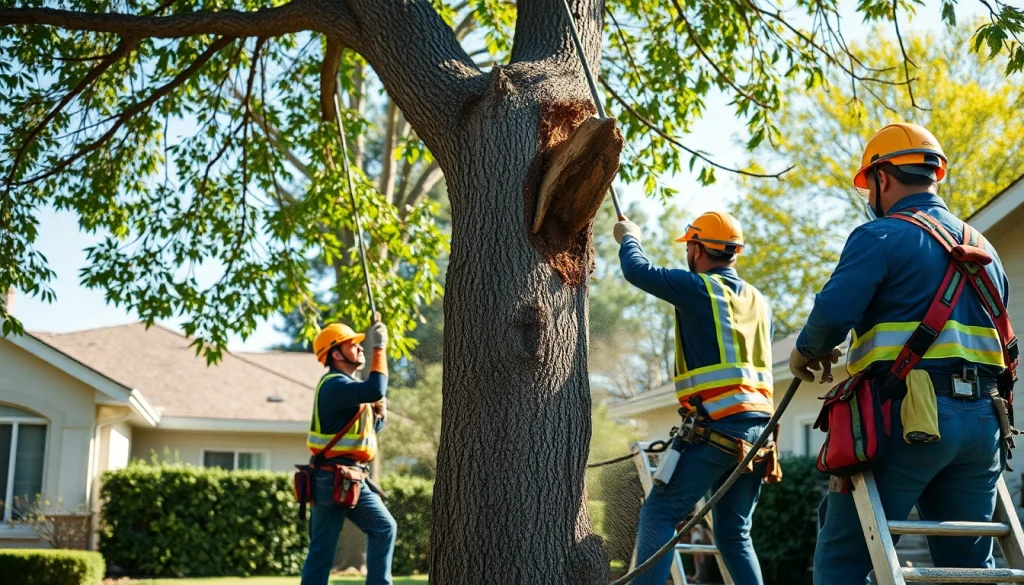
In the picturesque backdrop of trees surrounding our homes, they bring beauty, shade, and tranquility. However, with nature’s charm comes its unpredictability. When trees become hazardous, knowing when to engage an emergency tree service can make a significant difference. This article delves deep into understanding emergency tree services, their benefits, how to choose the right provider, cost factors, and post-emergency care options.
Understanding Emergency Tree Service
What Constitutes an Emergency in Tree Care?
Defining an emergency in tree care contextually requires an understanding of what trees signify to homeowners and the potential risks they pose. An emergency can be characterized by situations that pose immediate threats to life and property. For instance, a tree that has split and is leaning dangerously towards a house or power lines requires immediate intervention. Similarly, trees that have fallen onto a road blocking access or causing a hazard also qualify as emergencies.
Common Tree Emergencies Homeowners Face
Homeowners often encounter a variety of tree-related emergencies, including but not limited to:
- Fallen Trees: Could be due to strong winds, storms, or disease.
- Crown Damage: When a tree’s crown suffers severe branch loss, it can lead to structural instability.
- Tree Leaning: Trees that become unstable due to soil erosion or root damage can lean dangerously, risking collapse.
- Insect Infestations or Diseases: Trees harboring pests or diseases may weaken and become vulnerable to falling, especially in storms.
When to Call for Emergency Tree Service?
Certain indicators signal when it is time to call for professional assistance. If you notice a tree that has fallen or is leaning heavily towards buildings or power lines, it’s crucial to seek help immediately. Additionally, if branches are hanging on wires or if the tree shows signs of severe decay, contacting an emergency tree service is advisable. Your safety and the protection of your property should always be the priority.
Benefits of Professional Emergency Tree Services
Life-Saving Intervention: Protecting Property and People
The foremost benefit of professional emergency tree services is the immediate protection they afford to people and property. Time is of the essence, and professionals can assess and manage the situation promptly, often before any major damage occurs. Their trained eye can also spot potential hazards you might miss, ensuring safety within your environment.
Expertise in Safe Tree Removal Techniques
Emergency tree services possess the requisite knowledge and tools to remove trees safely. This process involves equipment like cranes, ropes, and saws operated by skilled arborists who understand tree anatomy and the safest techniques for removal. Their expertise minimizes risks associated with falling debris and ensures the safety of nearby structures and individuals.
Minimizing Damage with Quick Response Times
Many emergencies arise suddenly, which means rapid response is critical. Professional tree services are equipped to respond swiftly, often dispatching a team to your location within hours. This expedited action not only alleviates immediate risks but also limits the long-term damage to your property, potentially reducing repair costs.
Choosing the Right Emergency Tree Service Provider
Essential Credentials and Certifications to Look For
When selecting an emergency tree service provider, it’s essential to check for appropriate credentials and certifications. Look for companies that are members of relevant industry associations, such as the International Society of Arboriculture (ISA) or the Tree Care Industry Association (TCIA). These affiliations indicate that the company adheres to industry best practices and prioritizes safety and professionalism.
Evaluating Customer Reviews and Testimonials
Customer feedback can provide insight into the quality of service a company provides. Online reviews and testimonials can give you a sense of others’ experiences with a particular tree service. Pay attention to comments regarding responsiveness, quality of work, and customer service. An abundance of positive reviews can be a strong indicator of reliability.
Questions to Ask During Your Consultation
Before hiring an emergency tree service, consider asking the following questions:
- What is your response time for emergencies?
- Are you insured and licensed?
- Can you provide references from past clients?
- What measures do you take to ensure safety during tree removal?
Obtaining clear and thorough answers to these questions can help you make an informed decision.
Cost Factors of Emergency Tree Service
How Pricing Varies Based on Tree Size and Condition
Cost can significantly vary based on several factors, most importantly the size and condition of the tree. Generally, larger trees or those in poor health which require specialized equipment will command a higher fee. This is due to the increased labor time, risk factors, and equipment costs. A small, healthy tree might cost considerably less to remove than a large, hazardous one.
Insurance Coverage for Emergency Services
Many homeowners might be relieved to learn that their homeowners’ insurance could cover the costs associated with emergency tree removal. Policies vary widely, so it’s crucial to check your coverage details. Ensure to document any damage thoroughly and report it to your insurance provider as soon as possible.
Understanding Estimate vs. Final Costs
Getting an estimate is typically the first step in the process, and it’s essential to understand how final costs may differ. Estimates can change based on unforeseen circumstances, such as additional damage discovered during the removal process or the need for additional services like stump grinding or cleanup. Ensure the contract delineates these aspects clearly to avoid surprises.
Post-Emergency Tree Care and Replacement Options
Assessing Damage and Recovery Procedures
After an emergency tree removal, assessing any remaining damage is critical. A thorough inspection should consider the health of neighboring trees and the overall landscape. Depending on your findings, you may need to engage further services to help recover the landscape, such as fertilization, aeration, or soil amendments.
Choosing New Trees for Your Landscape
Post-emergency, you may be looking to replace a tree. It’s essential to choose species that are well-suited to your climate, soil type, and space. Consulting with a local arborist can provide insights into which trees thrive best in your environment and help prevent future emergencies. Factors to consider include disease resistance, growth patterns, and maintenance requirements.
Ongoing Maintenance to Prevent Future Emergencies
To mitigate future emergency situations, regular tree maintenance is vital. Schedule routine inspections and upkeep, including pruning and health assessments. Engaging a professional arborist to assess your trees can significantly reduce the likelihood of emergencies arising from neglect, thereby ensuring your landscape remains healthy and beautiful.






